You may not know this, but there are actually different ways and different food types to feed your pet during the summer. If you have an indoor pet in an environmentally controlled home, where the temperature and humidity stay relatively the same day after day, these tips probably don’t apply. But if your pet loves to spend time outdoors, if you don’t have or use an air conditioner for most of the year, or they reside in an outside kennel space, then these tips work great.
Hydration
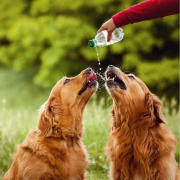 The best tip is actually a drinking tip, but it is the most important thing you can do for your pet. Always make sure there is plenty of water to drink on warm and hot summer days. Just like you, pets can become dehydrated out in the heat, and dehydration in animals can be life threatening. Put out a bowl or two of fresh water that is constantly refilled, to keep them hydrated and happy, and that’s the best feeding tip for your pets above all others.
The best tip is actually a drinking tip, but it is the most important thing you can do for your pet. Always make sure there is plenty of water to drink on warm and hot summer days. Just like you, pets can become dehydrated out in the heat, and dehydration in animals can be life threatening. Put out a bowl or two of fresh water that is constantly refilled, to keep them hydrated and happy, and that’s the best feeding tip for your pets above all others.
Hot and Cold Food Types
If you didn’t know this, there are actually hot and cold food types. For example, chicken, turkey and pork are considered “hot” meats, and they are best left out of the food plan on hot days. “Cold” foods, like whitefish, beef, rabbit and yogurt are better suited to a pet’s metabolism and won’t get them overheated and lethargic. Making a switch is easy to do, just alternate between colder food types on hot days and hotter food types on cooler days and your pet will be good to go.
Serving Hot and Cold Food
Just like you, your pet likes a good hot meal every so often, but feeding a hot meal on a hot day can quickly overheat them. Serving cold food on a hot day cools them off from the inside out and makes it much more comfortable to eat. Cold food doesn’t have to come from the refrigerator; room temperature is good enough, which will still probably be much cooler than the outside temperature.
Fruits and Veggies
Cooling snacks like fruits and veggies go a long way to keeping your pet cool. Most of these snacks are filled with water, so that’s another good way to keep your pet hydrated automatically. Plus, eating snacks like these are very refreshing on hot days. Adding fruits and veggies to your pet’s diet also represents one of the healthiest ways of improving their diet. Watermelon, blueberries, raspberries and broccoli are all good choices, while grapes raisins and onions are not so good. Just remember that large amounts of any fruit or vegetable will cause diarrhea, and that may lead to dehydration, which is what you absolutely do not want to occur.
Grain Free
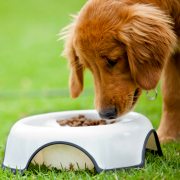 Most grains are considered “hot” foods mainly because it takes them longer to digest, so the internal digestion process of your pet works harder and therefore generates more heat. With a grain free diet, digestion is fast and efficient, so there is never any extra and unwanted heat generated from digesting it. Of course, stick with the types of cooler food types as listed above for the hotter days, and your pet will be smiling with every bite.
Most grains are considered “hot” foods mainly because it takes them longer to digest, so the internal digestion process of your pet works harder and therefore generates more heat. With a grain free diet, digestion is fast and efficient, so there is never any extra and unwanted heat generated from digesting it. Of course, stick with the types of cooler food types as listed above for the hotter days, and your pet will be smiling with every bite.
Shade Feeding
When feeding outside, get them into the shade so they can eat without the sun blaring down on them. You wouldn’t want to eat in full sun on a hot day, and neither would your pet, so do shade feeding in the summer to keep them cooler.
As an alternative, you can bump the feeding time during the evening until dusk or later. Your pet isn’t going to care when it eats, and if you feed at dusk or after dark, you’ll be letting them eat in the coolness that comes when the sun goes down.
Pet Food Only
 When you are out and about in your yard with family and friends, the temptation to give human food treats to begging pets can be almost overwhelming. But this is the time to resist giving pets any human food treats. Salty foods, like chips and pretzels, aren’t good for them and chocolate can make them seriously ill. Alcoholic drinks are a serious no-no, and artificially sweetened beverages, candies, cakes and the like can actually cause death.
When you are out and about in your yard with family and friends, the temptation to give human food treats to begging pets can be almost overwhelming. But this is the time to resist giving pets any human food treats. Salty foods, like chips and pretzels, aren’t good for them and chocolate can make them seriously ill. Alcoholic drinks are a serious no-no, and artificially sweetened beverages, candies, cakes and the like can actually cause death.
Kids are serious offenders here, they just want to be involved and love the feeding interaction. If need be, you may have to keep your pet in the house or outdoor kennel while the festivities are going on, just to keep them protected from any kind of dangerous human food that they may be offered.
Feeding pets in the summer isn’t a radical change, but for their health and well being, a summer diet that includes the tips above will go a long way to keeping your pet cool and comfortable all summer long.
Written by: Mary Nielsen
Mary Nielsen founded FelineLiving.net and is a passionate cat lover, blogger, and part-time music teacher. She founded her blog to share her ups and downs of being a pet parent to a number of adorable kittens and cats. When she is not playing with them or teaching, you can find her experimenting in the kitchen.

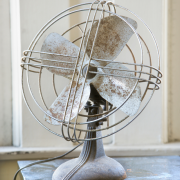 Other tricks to keep your dog cool are fairly obvious. Keep your dog hydrated, use air conditioners or fans and even frozen treats to beat the heat. Limit outdoor activity during the hottest period of the day, which is typically between 1PM and 4PM. When walking try to keep your dog on the grass instead of the asphalt, and stick to the shady side of the street. If your dog will need to be on asphalt for an extended period of time, put down a towel for him to stand on.
Other tricks to keep your dog cool are fairly obvious. Keep your dog hydrated, use air conditioners or fans and even frozen treats to beat the heat. Limit outdoor activity during the hottest period of the day, which is typically between 1PM and 4PM. When walking try to keep your dog on the grass instead of the asphalt, and stick to the shady side of the street. If your dog will need to be on asphalt for an extended period of time, put down a towel for him to stand on.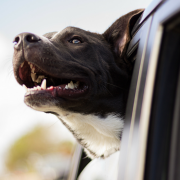 While your dog may like to take road trips with you, it should go without saying that you should never leave your dog in the car. On a mild day, where the temperature is 70 degrees, the internal temperature of the car can reach almost 100 degrees in a span of 20 minutes. If it’s 85 degrees outside it will reach a sweltering 104 degrees in as little as ten minutes. Even if you leave the windows open and park in the shade, the car will still be too hot for your dog.
While your dog may like to take road trips with you, it should go without saying that you should never leave your dog in the car. On a mild day, where the temperature is 70 degrees, the internal temperature of the car can reach almost 100 degrees in a span of 20 minutes. If it’s 85 degrees outside it will reach a sweltering 104 degrees in as little as ten minutes. Even if you leave the windows open and park in the shade, the car will still be too hot for your dog.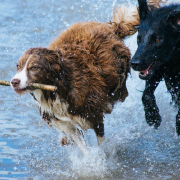 Swimming is a great reprieve from the harsh summer sun. Definitely invest in a good life vest for your dog, get one that is brightly colored so that you and others can easily spot him in the water. At the beach or at rivers be on the lookout for riptides because your pet could quickly be swept out to sea. In a lake or a pond, skip the swim if it is covered in blue-green algae, it could be toxic to your dog. If you have a pool you need to train him how to exit the pool by himself, make sure that you practice it over and over and over so that he’ll remember how to get out if he gets tired or falls in. You might also want to consider getting a dog friendly ramp installed in the deep end of the pool for good measure.
Swimming is a great reprieve from the harsh summer sun. Definitely invest in a good life vest for your dog, get one that is brightly colored so that you and others can easily spot him in the water. At the beach or at rivers be on the lookout for riptides because your pet could quickly be swept out to sea. In a lake or a pond, skip the swim if it is covered in blue-green algae, it could be toxic to your dog. If you have a pool you need to train him how to exit the pool by himself, make sure that you practice it over and over and over so that he’ll remember how to get out if he gets tired or falls in. You might also want to consider getting a dog friendly ramp installed in the deep end of the pool for good measure. The best tip is actually a drinking tip, but it is the most important thing you can do for your pet. Always make sure there is plenty of water to drink on warm and hot summer days. Just like you, pets can become dehydrated out in the heat, and
The best tip is actually a drinking tip, but it is the most important thing you can do for your pet. Always make sure there is plenty of water to drink on warm and hot summer days. Just like you, pets can become dehydrated out in the heat, and  Most grains are considered “hot” foods mainly because it takes them longer to digest, so the internal digestion process of your pet works harder and therefore generates more heat. With a grain free diet, digestion is fast and efficient, so there is never any extra and unwanted heat generated from digesting it. Of course, stick with the types of cooler food types as listed above for the hotter days, and your pet will be smiling with every bite.
Most grains are considered “hot” foods mainly because it takes them longer to digest, so the internal digestion process of your pet works harder and therefore generates more heat. With a grain free diet, digestion is fast and efficient, so there is never any extra and unwanted heat generated from digesting it. Of course, stick with the types of cooler food types as listed above for the hotter days, and your pet will be smiling with every bite. When you are out and about in your yard with family and friends, the temptation to give human food treats to begging pets can be almost overwhelming. But this is the time to resist giving pets any human food treats. Salty foods, like chips and pretzels, aren’t good for them and
When you are out and about in your yard with family and friends, the temptation to give human food treats to begging pets can be almost overwhelming. But this is the time to resist giving pets any human food treats. Salty foods, like chips and pretzels, aren’t good for them and